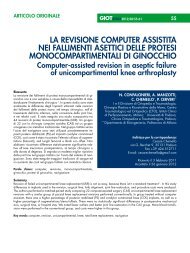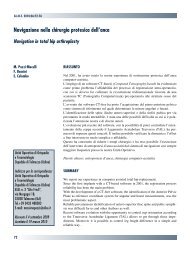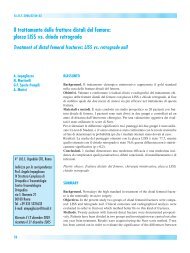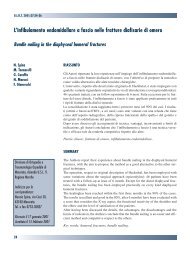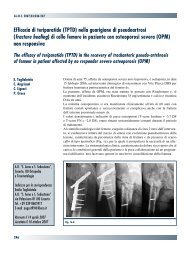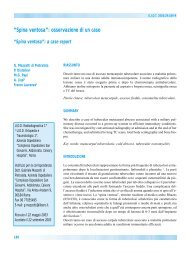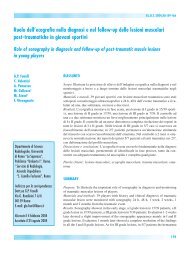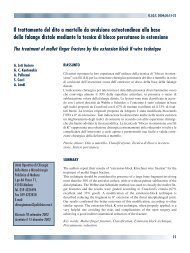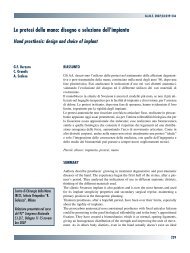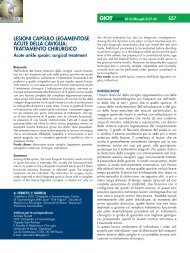30845 Suppl Giot.pdf - Giornale Italiano di Ortopedia e Traumatologia
30845 Suppl Giot.pdf - Giornale Italiano di Ortopedia e Traumatologia
30845 Suppl Giot.pdf - Giornale Italiano di Ortopedia e Traumatologia
You also want an ePaper? Increase the reach of your titles
YUMPU automatically turns print PDFs into web optimized ePapers that Google loves.
Graft biomimetici-attivi nella chirurgia legamentosa del ginocchio<br />
G. Cerulli * ** , F. Vercillo **<br />
rIaSSuNTO<br />
I materiali bioattivi sono stati l’oggetto del nostro stu<strong>di</strong>o in collaborazione<br />
con la XIII Università <strong>di</strong> Parigi. La <strong>di</strong>fferenza tra il<br />
graft bioattivo in poliestere usato come scaffold ed il collagene<br />
<strong>di</strong> tipo 1 è che, sebbene entrambi vengono colonizzati da tessuto<br />
cicatriziale, il collagene, nella sua ultima fase, viene rimodellato in<br />
un efficente collagene <strong>di</strong> tipo I-III. Sull’attuale legamento Lars il<br />
tipo <strong>di</strong> collagene non subisce nessuna trasformazione. Con il graft<br />
bioattivo il sistema immunitario riconosce la molecola inglobata e<br />
la considera come parte dell’organismo. Come con l’attuale graft<br />
sintetico, non c’è intolleranza ma una vera integrazione biologica.<br />
I fibroblasti si fissano alla matrice extra-cellulare, sferici inizialmente<br />
poi <strong>di</strong>ventano fusiformi, che è la con<strong>di</strong>zione essenziale per<br />
la loro attivazione e secrezione <strong>di</strong> collagene I-III. Il riconoscimento<br />
dei biomateriali è dovuto alla presenza <strong>di</strong> gruppi chimici all’interno<br />
<strong>di</strong> molecole che si comportano come un sistema biologico chiave<br />
serratura che raggira il sistema immunitario che le considera come<br />
self. È stato scoperto che il polistirene sulfonato <strong>di</strong> so<strong>di</strong>o può essere<br />
fissato sulla intera superficie delle fibre <strong>di</strong> polistirene, i fibroblasti<br />
lo riconoscono come eparan solfato e ciò determina la loro adesione<br />
in modo lineare e forte. Nel nostro stu<strong>di</strong>o in vivo su animali, 16<br />
pecore sono state <strong>di</strong>vise in due gruppi: il primo gruppo è stato sottoposto<br />
a ricostruzione del legamento crociato anteriore (LCA) con<br />
la seconda generazione dei legamenti <strong>di</strong> sintesi (Lars), il secondo<br />
gruppo con il graft sintetico biomimetico. I risultati sono promettenti<br />
con nessun problema postoperatorio o funzionale. Le prime<br />
pecore sono state sacrificate a 6 mesi ed i primi risultati istologici<br />
non mostrano alcuna risposta infiammatoria né fibrosi in ciascun<br />
gruppo, e nel gruppo che ha ricevuto il polimero bioattivo c’era una<br />
<strong>di</strong>fferenza statisticamente significativa nella <strong>di</strong>stribuzione cellulare<br />
se confrontato con il primo gruppo; infatti nel graft bioattivo i<br />
fibroblasti erano ben organizzati ed orientati con collagene tipo I/<br />
III. I risultati istologici a 12 mesi sono in progress. Sulla base <strong>di</strong><br />
questi incoraggianti risultati stiamo pianificando lo stu<strong>di</strong>o <strong>di</strong> fase<br />
clinica I sul modello umano nella speranza <strong>di</strong> ottenere una risposta<br />
simile dal corpo umano.<br />
* Dipartimento <strong>di</strong> Ortope<strong>di</strong>a e <strong>Traumatologia</strong>, Università degli Stu<strong>di</strong> <strong>di</strong> Perugia;<br />
* Nicola’s Foundation ONLUS, Arezzo<br />
In<strong>di</strong>rizzo per la corrispondenza:<br />
Giuliano Cerulli, Ortope<strong>di</strong>a & <strong>Traumatologia</strong>, Via G.B. Pontani 9, 06127 Perugia.<br />
Tel. +39 075 5058485. Fax 075 5010921. E-mail: g_cerulli@tin.it<br />
SuMMary<br />
G.I.O.T. 2010;36(suppl. 1):S175-S177<br />
Bioactive materials have been the object of our research work in<br />
collaboration with the XIII University of Paris. The <strong>di</strong>fference<br />
between the bioactive polyester graft used as a scaffold and the<br />
collagen one is that, although both are colonized by fibrotic scar<br />
tissue, the collagen, in the late phase, is remodelled in efficient<br />
type I/III collagen. On the present Lars ligament the collagen<br />
type remains unchanged. With the bioactive graft the immune<br />
system recognises the molecule inserted and considers it as being<br />
a part of the organism. As with the present synthetic graft, there<br />
is no intolerance but in ad<strong>di</strong>tion true biologic integration. The<br />
fibroblasts fix onto the extra cellular matrix; initially spherical<br />
they become spindle-shaped, which is an essential con<strong>di</strong>tion for<br />
them to be activated and secrete collagen I/III. The recognition of<br />
the biomaterials is due to the presence of chemical groups within<br />
the molecule acting as a biologic key/lock system which misled<br />
the immune system into recognizing them. It was found that the<br />
polystyrene so<strong>di</strong>um sulphate can be fixed onto the whole surface<br />
of polyester fibres, the fibroblasts recognize it as a heparin sulphate<br />
and cause their adhesion in a linear and strong manner. In<br />
our animal study, 16 sheep were <strong>di</strong>vided into two groups: the first<br />
one underwent ACL reconstruction with the second generation<br />
synthetic ligament, the second group with the biomimetic synthetic<br />
graft. The results are promising with no post-operative or<br />
functional problems. The first sheep were sacrificed at 6 months<br />
and the first histological results show no inflammatory response<br />
nor fibrosis in either group and in the group which received<br />
the bioactive polymer there was a significant <strong>di</strong>fference in cell<br />
<strong>di</strong>stribution compared to the first group; in deed in the bioactive<br />
graft the fibroblasts were well organized and oriented with type<br />
I/III collagen. The histological results at 12 months are on-going.<br />
Based on these encouraging results we are planning a clinical<br />
phase one study in the human model hoping to achieve a similar<br />
response from the human body.<br />
L’uso <strong>di</strong> graft biologici, sia autologhi che prelevati da cadavere,<br />
è una procedura ad oggi standar<strong>di</strong>zzata, della quale sono ben noti<br />
i relativi vantaggi e svantaggi, le in<strong>di</strong>cazioni, e le modalità ed i<br />
tempi <strong>di</strong> recupero post-operatorio. L’utilizzo <strong>di</strong> innesti biologici<br />
autologhi (es. GrST, BPTB, Gr o ST etc), rappresenta la procedura<br />
che potenzialmente è in grado <strong>di</strong> dare i migliori risultati in termini<br />
<strong>di</strong> stabilità a lungo termine con un graft dotato <strong>di</strong> elevata resistenza,<br />
ciò a <strong>di</strong>scapito della morbilità del sito donatore, un maggior<br />
numero <strong>di</strong> complicanze intraoperatorie e postoperatorie, e tempi <strong>di</strong><br />
recupero sportivo che si aggirano in me<strong>di</strong>a sui 5-6 mesi. Inoltre a<br />
seconda del graft bilogico utilizzato, i tempi <strong>di</strong> ligamentizzazione<br />
S175



